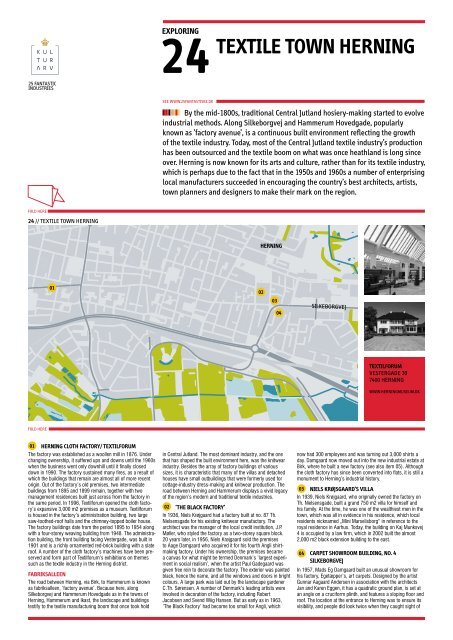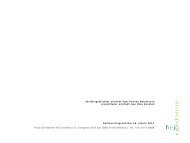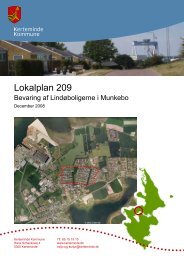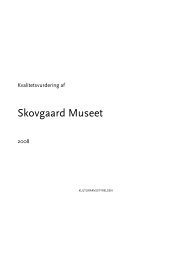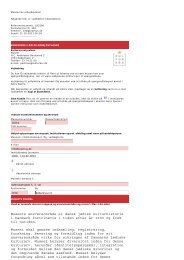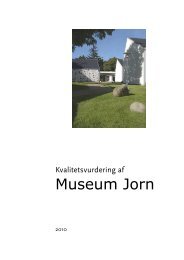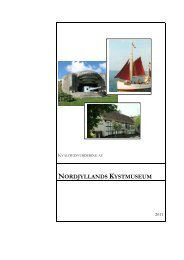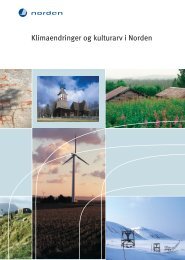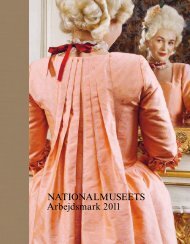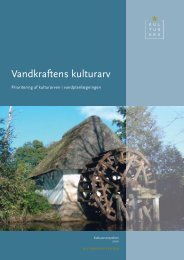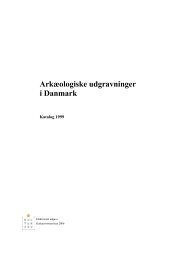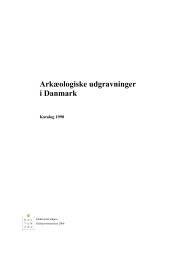TEXTILE TOWN HERNING
TEXTILE TOWN HERNING
TEXTILE TOWN HERNING
You also want an ePaper? Increase the reach of your titles
YUMPU automatically turns print PDFs into web optimized ePapers that Google loves.
exploring<br />
24<br />
Textile town Herning<br />
25 fantastic<br />
industries<br />
SEe WWW.25FANTASTISKE.DK<br />
By the mid-1800s, traditional Central Jutland hosiery-making started to evolve<br />
industrial methods. Along Silkeborgvej and Hammerum Hovedgade, popularly<br />
known as ’factory avenue’, is a continuous built environment reflecting the growth<br />
of the textile industry. Today, most of the Central Jutland textile industry’s production<br />
has been outsourced and the textile boom on what was once heathland is long since<br />
over. Herning is now known for its arts and culture, rather than for its textile industry,<br />
which is perhaps due to the fact that in the 1950s and 1960s a number of enterprising<br />
local manufacturers succeeded in encouraging the country’s best architects, artists,<br />
town planners and designers to make their mark on the region.<br />
fold here<br />
24 // Textile town Herning<br />
herning<br />
01<br />
02<br />
03<br />
04<br />
silkeborgvej<br />
textilforum<br />
vestergade 20<br />
7400 herning<br />
www.herningmuseum.dk<br />
fold here<br />
01 <strong>HERNING</strong> CLOTH FACTORY/ Textilforum<br />
The factory was established as a woollen mill in 1876. Under<br />
changing ownership, it suffered ups and downs until the 1960s<br />
when the business went only downhill until it finally closed<br />
down in 1990. The factory sustained many fires, as a result of<br />
which the buildings that remain are almost all of more recent<br />
origin. Out of the factory’s old premises, two intermediate<br />
buildings from 1895 and 1899 remain, together with two<br />
management residences built just across from the factory in<br />
the same period. In 1996, Textilforum opened the cloth factory’s<br />
expansive 3,000 m2 premises as a museum. Textilforum<br />
is housed in the factory’s administration building, two large<br />
saw-toothed-roof halls and the chimney-topped boiler house.<br />
The factory buildings date from the period 1895 to 1954 along<br />
with a four-storey weaving building from 1948. The administration<br />
building, the front building facing Vestergade, was built in<br />
1901 and is a richly ornamented red-brick building with a slate<br />
roof. A number of the cloth factory’s machines have been preserved<br />
and form part of Textilforum’s exhibitions on themes<br />
such as the textile industry in the Herning district.<br />
FABRIKSALLEEN<br />
The road between Herning, via Birk, to Hammerum is known<br />
as fabriksalleen, ’factory avenue’. Because here, along<br />
Silkeborgvej and Hammerum Hovedgade as in the towns of<br />
Herning, Hammerum and Ikast, the landscape and buildings<br />
testify to the textile manufacturing boom that once took hold<br />
in Central Jutland. The most dominant industry, and the one<br />
that has shaped the built environment here, was the knitwear<br />
industry. Besides the array of factory buildings of various<br />
sizes, it is characteristic that many of the villas and detached<br />
houses have small outbuildings that were formerly used for<br />
cottage-industry dress-making and knitwear production. The<br />
road between Herning and Hammerum displays a vivid legacy<br />
of the region’s modern and traditional textile industries.<br />
02 ’THE BLACK FACTORY’<br />
In 1936, Niels Krøjgaard had a factory built at no. 87 Th.<br />
Nielsensgade for his existing knitwear manufactory. The<br />
architect was the manager of the local credit institution, J.P.<br />
Møller, who styled the factory as a two-storey square block.<br />
20 years later, in 1956, Niels Krøjgaard sold the premises<br />
to Aage Damgaard who acquired it for his fourth Angli shirtmaking<br />
factory. Under his ownership, the premises became<br />
a canvas for what might be termed Denmark’s ’largest experiment<br />
in social realism’, when the artist Paul Gadegaard was<br />
given free rein to decorate the factory. The exterior was painted<br />
black, hence the name, and all the windows and doors in bright<br />
colours. A large park was laid out by the landscape gardener<br />
C.Th. Sørensen. A number of Denmark’s leading artists were<br />
involved in decoration of the factory, including Robert<br />
Jacobsen and Svend Wiig Hansen. But as early as in 1963,<br />
’The Black Factory’ had become too small for Angli, which<br />
now had 300 employees and was turning out 3,000 shirts a<br />
day. Damgaard now moved out into the new industrial estate at<br />
Birk, where he built a new factory (see also item 05). Although<br />
the cloth factory has since been converted into flats, it is still a<br />
monument to Herning’s industrial history.<br />
03 Niels Krøjsgaard’s villa<br />
In 1939, Niels Krøjgaard, who originally owned the factory on<br />
Th. Nielsensgade, built a grand 750 m2 villa for himself and<br />
his family. At the time, he was one of the wealthiest men in the<br />
town, which was all in evidence in his residence, which local<br />
residents nicknamed „Mini Marselisborg“ in reference to the<br />
royal residence in Aarhus. Today, the building on Kaj Munksvej<br />
4 is occupied by a law firm, which in 2002 built the almost<br />
2,000 m2 black extension building to the east.<br />
04 Carpet showroom building, No. 4<br />
Silkeborgvej<br />
In 1957, Mads Eg Damgaard built an unusual showroom for<br />
his factory, Egetæpper’s, art carpets. Designed by the artist<br />
Gunnar Aagaard Andersen in association with the architects<br />
Jan and Karen Eggen, it has a quadratic ground plan, is set at<br />
an angle on a cruciform plinth, and features a sloping floor and<br />
roof. The location at the entrance to Herning was to ensure its<br />
visibility, and people did look twice when they caught sight of
this unconventional building. In this way, the building fulfilled its<br />
aim: to be an eye-catching and hence effective advertisement<br />
for Egetæpper. The two Damgaard brothers’ association with<br />
modern artists has been a strongly influential factor in the rich<br />
cultural life of modern Herning.<br />
05 Egetæpper (Carpets)<br />
Mads Eg Damgaard, the founder of the Egetæpper carpet<br />
empire, took at giant leap in 1953 when he wound up his textile<br />
production, sacked all 150 employees except 15 and instead<br />
bought machinery for weaving high-quality Axminster carpets.<br />
But his strategy was successful. Initially, Damgaard’s new factory<br />
had 3 Axminster looms but soon after no fewer than 44,<br />
all in uninterrupted, three-shift operation. The early 1960s saw<br />
the advent of the next technological revolution in the carpet<br />
industry: the tufting loom. Egetæpper went from strength to<br />
strength, moving from a small factory by the original showroom<br />
on Silkeborgvej to this vast, 35,000 m2 complex on<br />
Industrivej. The new premises had space for the large tufting<br />
looms and by 1971, production at the new address was in<br />
full swing. This large factory, which surpassed everything<br />
in the Herning region, was designed by the architect Kaj<br />
fold here<br />
Boeck-Hansen, but underwent extensive alteration in 1982<br />
when it was given a new facade and a showroom and reception<br />
building designed by the Aarhus architect C.F. Møller .<br />
In 1984, a showroom and administration building was added,<br />
also designed by Møller. During this period the architect<br />
created a large number of screening frontages around industrial<br />
plants. The frontage at Egetæpper is around 300 metres long<br />
and is intersected by the large showroom and Søren Georg<br />
Jensen sculptures. The showroom interior is decorated with<br />
wall carpets by the artists Pierre Wermaëre and Asger Jorn<br />
and the atrium garden contains Rudolf Tegner’s sculpture<br />
„Leda and the Swan“. The business is still in operation, but is<br />
today known solely as ’Ege’.<br />
06 ’THE ROUND FACTORY’<br />
When Angli, the shirt-maker’s, outgrew ’The Black Factory’,<br />
Aage Damgaard acquired a large property at Birk. Based on<br />
a concept created by C.Th. Sørensen, ’the Round Factory’<br />
was built in 1965, and the architect was C.F. Møller. C.Th.<br />
Sørensen’s original sketch consisted of two off-centre circles<br />
giving onto a circular courtyard. The sculptures and artworks<br />
from the Black Factory were moved to Birk and C. Th.<br />
Sørensen designed the circular sculpture park. Hereford cattle<br />
were purchased to graze on the circular turf in the park, which<br />
subsequently inspired the idea for the next venture, what is<br />
now a chain of restaurants called Hereford Beefstouw, and<br />
RELATED SITES:<br />
Herning Cloth Factory / Textilforum<br />
Vestergade 20<br />
7400 Herning<br />
www.textilforum.dk<br />
Herning museum of art – heart<br />
Birk Centerpark 8<br />
7400 Herning<br />
www.heartmus.dk<br />
birk<br />
05<br />
06<br />
silkeborgvej<br />
07<br />
08<br />
hammerum<br />
fold here<br />
new artists were contracted to decorate the factory, including<br />
Piero Manzoni, famed for his tin can work containing „Artist’s<br />
shit“. In 1968, Carl-Henning Pedersen’s ceramic frieze was<br />
unveiled in the courtyard: „Picture cycle. The book of imagination<br />
about the wheel of life“. But by 1974, the shirt-making<br />
boom had petered out, and Aage Damgaard shut up shop . The<br />
factory was sold to an arts and education foundation, Midtjysk<br />
Skole- og Kulturfond, set up in 1973. The large art collection<br />
was donated to Herning local authority for the purpose of<br />
establishing a museum of art. Part of the Angli factory was<br />
fitted out for a garment design school, while other parts were<br />
used by Herning Museum of Art from its establishment in 1977<br />
until 2009 when the new museum of art in Herning, HEART,<br />
was completed further along Birk Centerpark at no. 8.<br />
07 Niels Larsen knitwear factory<br />
In 1872, the wool shop keeper Niels Larsen purchased a<br />
rotary power framework machine and he and his wife stepped<br />
up their production of woollen garments. Their business was<br />
soon ready for expansion. In 1883, Larsen acquired the<br />
Hammerumholm estate, where the manufactory gradually<br />
expanded. In 1917, following the death of Niels Larsen, his<br />
widow and son Otto Larsen had the factory building on<br />
Vestergade built. The factory was in operation at this location<br />
until it closed down in 1986. In the late 1990s, Niels Larsen’s<br />
1,500-m2 factory was converted into flats, while the original<br />
factory front facing the road was preserved. Herning Museum<br />
contains a collection of products from the factory including<br />
men’s and women’s underwear, blouses and gym slips.<br />
08 Jensen & Stampe<br />
In the town of Hammerum, Iver Nielsen established a knitwear<br />
factory as early as in 1870, A few years later he moved his<br />
business to what is now no. 95A Hammerum Hovedgade. Not<br />
until later was the factory given the name Jensen & Stampe.<br />
The oldest factory building, two storeys high and facing the<br />
main street, dates from circa 1890. This building is not only<br />
the oldest from this factory, but the oldest textile building in the<br />
district of Hammerum. In 1917-18, a new, larger building was<br />
established at right angles to the main street. This was built<br />
to house a modern knitwear factory, with state-of-the-art<br />
machines. Jensen & Stampe was one of the first businesses<br />
to switch from steam power to electricity in 1906 after<br />
Hammerum gained its own electricity works in 1905. Holger<br />
Jensen, one of the factory’s owners, also happened to be the<br />
electricity works’ chairman. The business did well for many<br />
years, but in 1994, the factory closed down and the premises<br />
were converted into flats. The original exterior of the oldest<br />
building was preserved, however, as a monument to the<br />
district’s oldest knitwear factory.


